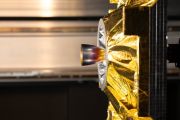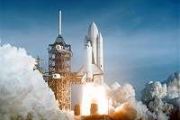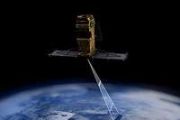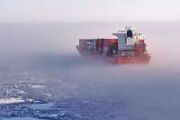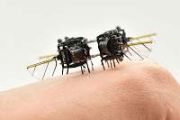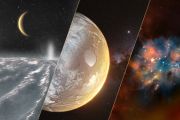
Copernical Team
A summer science smorgasbord: Sols 3505-3506
 The difficulty of driving on Martian terrain proves itself once again! Our Sol 3504 drive did not complete successfully, leaving us in basically the same spot as our last plan. Thankfully, all the science we planned executed successfully: check out an interesting Dust Removal Tool result on "Omai" showing erosion-resistant veins beneath the surface and a MAHLI closeup of ChemCam's eye where the
The difficulty of driving on Martian terrain proves itself once again! Our Sol 3504 drive did not complete successfully, leaving us in basically the same spot as our last plan. Thankfully, all the science we planned executed successfully: check out an interesting Dust Removal Tool result on "Omai" showing erosion-resistant veins beneath the surface and a MAHLI closeup of ChemCam's eye where the Researcher awarded $100,000 to identify potential fuel source on Mars
 Associate professor Vincent Chevrier at the U of A Center for Space and Planetary Sciences was awarded $100,000 to study the stability and distribution of clathrate hydrates and clathrasils on the surface of Mars in hopes of discovering a source of methane.
Identifying probable sources of methane would be a critical step in advancing the exploration of Mars, as methane could be utilized to
Associate professor Vincent Chevrier at the U of A Center for Space and Planetary Sciences was awarded $100,000 to study the stability and distribution of clathrate hydrates and clathrasils on the surface of Mars in hopes of discovering a source of methane.
Identifying probable sources of methane would be a critical step in advancing the exploration of Mars, as methane could be utilized to NASA spacecraft observes Asteroid Bennu's boulder 'Body Armor'
 Asteroid Bennu's boulder-covered surface gives it protection against small meteoroid impacts, according to observations of craters by NASA's OSIRIS-REx (Origins, Spectral Interpretation, Resource Identification, Security-Regolith Explorer) spacecraft.
"These observations give new insight into how asteroids like Bennu respond to energetic impacts," said Edward (Beau) Bierhaus of Lockheed Ma
Asteroid Bennu's boulder-covered surface gives it protection against small meteoroid impacts, according to observations of craters by NASA's OSIRIS-REx (Origins, Spectral Interpretation, Resource Identification, Security-Regolith Explorer) spacecraft.
"These observations give new insight into how asteroids like Bennu respond to energetic impacts," said Edward (Beau) Bierhaus of Lockheed Ma Three-stage engine of China's new manned carrier rocket to enter prototype development
 A three-stage engine of China's new generation manned carrier rocket will go to prototype sample development, according to the China Aerospace Science and Technology Corporation.
The long-distance and multiple ignition tests of the engine have been successfully completed, indicating that it is ready to enter the next stage of prototype sample development.
The test examined the key te
A three-stage engine of China's new generation manned carrier rocket will go to prototype sample development, according to the China Aerospace Science and Technology Corporation.
The long-distance and multiple ignition tests of the engine have been successfully completed, indicating that it is ready to enter the next stage of prototype sample development.
The test examined the key te NASA mission discovers 2 Earth-like exoplanets
 NASA announced Wednesday it discovered two rocky exoplanets similar to Earth orbiting a dwarf star near our solar system but are believed to both be too hot to sustain life as we know it.
The space agency's Transiting Exoplanet Survey Satellite mission, or TESS, said the planets are 33 light-years away, some of the closest rocky exoplanets ever found.
"Both planets rate in the to
NASA announced Wednesday it discovered two rocky exoplanets similar to Earth orbiting a dwarf star near our solar system but are believed to both be too hot to sustain life as we know it.
The space agency's Transiting Exoplanet Survey Satellite mission, or TESS, said the planets are 33 light-years away, some of the closest rocky exoplanets ever found.
"Both planets rate in the to Mysterious 'blue blobs' reveal a new kind of star system
 University of Arizona astronomers have identified five examples of a new class of stellar system. They're not quite galaxies and only exist in isolation.
The new stellar systems contain only young, blue stars, which are distributed in an irregular pattern and seem to exist in surprising isolation from any potential parent galaxy.
The stellar systems - which astronomers say appear thr
University of Arizona astronomers have identified five examples of a new class of stellar system. They're not quite galaxies and only exist in isolation.
The new stellar systems contain only young, blue stars, which are distributed in an irregular pattern and seem to exist in surprising isolation from any potential parent galaxy.
The stellar systems - which astronomers say appear thr 4 buildings at observatory in Arizona lost in wildfire

Four non-scientific buildings at the Kitt Peak National Observatory southwest of Tucson were lost in a wildfire, but early indications show other buildings on the property didn't appear to be damaged, authorities said Saturday.
Buell T. Jannuzi, who leads the Department of Astronomy at the University of Arizona, said the fire didn't appear to have damaged the telescope and science buildings at the observatory, though a closer examination of the site hadn't yet been made due to safety concerns.
"This is the most threatening fire I can remember at Kitt Peak in the last 25 years," Jannuzi said.
The fire reached the observatory early Friday. Crews were planning to assess the damage at the observatory later Saturday if conditions allowed for safe entry into the area.
Kitt Peak National Observatory is operated by NOIRLab, the National Science Foundation's center for ground-based optical-infrared astronomy. The University of Arizona, which has had a telescope at the site since 1962, is a tenant of the observatory.
The lightning-caused fire, which led to an evacuation of the observatory earlier this week, had grown to 27 square miles (71 kilometers) by Saturday.
SpaceX Falcon 9 launches for its 13th time, a record for the company
 A SpaceX Falcon 9 lifted off on its record 13th launch on Friday afternoon as it sent 53 Starlink satellites into orbit.
The rocket took off from pad 39A at Kennedy Space Center, with the first stage sticking a successful return and landing at the Shortfall of Gravitas drone ship shortly after lift off.
SpaceX said the same first stage booster support was used in the GPS III-3, T
A SpaceX Falcon 9 lifted off on its record 13th launch on Friday afternoon as it sent 53 Starlink satellites into orbit.
The rocket took off from pad 39A at Kennedy Space Center, with the first stage sticking a successful return and landing at the Shortfall of Gravitas drone ship shortly after lift off.
SpaceX said the same first stage booster support was used in the GPS III-3, T Did a giant radio telescope in China just discover aliens? Not so FAST
 This phrase is the standard that astronomers will be applying to a curious signal captured with China's "Sky Eye" telescope that might be a transmission from alien technology.
An article reporting the signal was posted on the website of China's state-backed Science and Technology Daily newspaper, but was later removed. So have astronomers finally found evidence of intelligent found life be
This phrase is the standard that astronomers will be applying to a curious signal captured with China's "Sky Eye" telescope that might be a transmission from alien technology.
An article reporting the signal was posted on the website of China's state-backed Science and Technology Daily newspaper, but was later removed. So have astronomers finally found evidence of intelligent found life be Webb's mid-infrared spectroscopy will reveal molecules, elements














